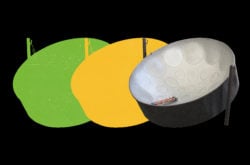Illustration: Daniel Batista
Hang, pantam, UFO drum—these names all belong to the handpan, a relatively new family of percussive instruments that share a unique, hypnotic sound.
Coming in numerous shapes, sizes, and tunings, these domed metallic drums produce smooth ambient tones when played with both hands. In this article, let’s explore the history, features, and future of the handpan family.
The history of the hang
The modern handpan is closely related to and based on the traditional Caribbean steel drum or steel pan, which originates from Trinidad and Tobago. The hang (meaning both “hand” and “hillside” in Bernese German) was a term coined by longtime steel pan manufacturers Felix Rohner and Sabina Schärer as they embarked on a new project. After building steel pans for decades, they sought to merge its characteristics with those of other instruments like the gamelan of Indonesia, the gong of Thailand, and the ghatam of India to create something that could be played with just your hands.
Since its creation in 2000, the hang has gone through multiple changes and sparked widespread interest which has since led to the development of other similar instruments that fall into the handpan family. Well over 300 handpan makers exist across the globe today, and each one offers a slightly different product.
How does the handpan work?
The handpan is known as an idiophone, which is an instrument that generates sound primarily through its own vibration and without the aid of forced air, strings, stretched membranes, or electricity. Other instruments that fall into this category include cymbals, bells, tambourines, and even mallet instruments like xylophones or marimbas.
Even though specific designs may differ slightly, handpans are always constructed of two convex steel halves that are glued together (sometimes giving the impression of a flying saucer). The upper half of the instrument (see this labeled image) features a central dome called a Ding which creates the root or bass note, while the Gu is an opening on the underside of the instrument that helps it resonate and produce the warm, long tones characteristic of a handpan.
Arranged in a circle around the Ding are at least seven indents, each representing a specific note and tuned according to a certain scale like major, minor, or harmonic minor, along with many others. While this setup does remove some choice, it also makes it easier for someone new to start playing and improvise more freely, since there are essentially no “wrong” notes from a harmonic perspective.
While this instrument is played with your hands, it creates soft mallet-like notes that are rich in harmonics. The resulting sound can vary in both tone and sustain depending on which part of the hand is being used and exactly where the surface is being struck. While each instrument can only play a single scale, it’s possible to set up multiple handpans with scales that complement each other and play them all together.
How can I hear more?
If you happen to check out a store that sells these instruments, the first thing you may notice is the price—they can range from $1,000 to over $3,000 dollars! Despite the hundreds of handpan makers out there, these instruments really cannot be mass-produced and usually take months for skilled builders to finish by hand. This consistent demand combined with relatively low supply has led to high prices—but this is still nothing out of the ordinary when you consider the cost of many other high-quality musical instruments. That said, if you’d rather just tip your toes into the sonic identity of the instrument first, here are some curated handpan samples from Splice Sounds that you can explore and incorporate into your own music.
All in all, the handpan is centered around immersion; it’s meant to be intuitive, engaging, and creatively freeing, which makes it great for both amateurs and professional musicians alike. Handpans have been featured all over the music spectrum, used in everything from meditation exercises to the Minecraft soundtrack. Where else have you heard its characteristic sound? Let us know in the comments below.
Incorporate mesmerizing handpan one-shots and loops into your own productions:
March 4, 2022



